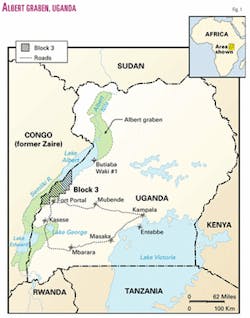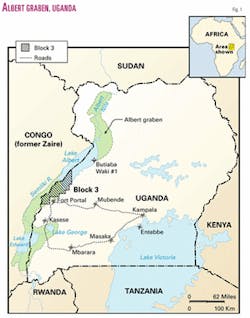Meeting exploration challenges in Uganda's remote Albert graben
Heritage Oil & Gas Corp. and partner Energy Africa Ltd. are poised to drill their first exploration well in the Albert graben of western Uganda in August 2002 (Fig. 1).
This drilling campaign is the culmination of a 5-year exploration work program, including two seasons of seismic acquisition, which has demonstrated that the Albert graben has the potential to be a new and significant hydrocarbon province.
The potential of the Albert graben as a hydrocarbon province has long been recognized, but the basin has never been properly tested. Heritage's seismic in 1998 was the first acquired in Uganda, and the forthcoming exploration drilling will evaluate what is essentially an untested basin. Inevitably this poses the question, why has industry so neglected such a prospective basin?
Part one of this article (OGJ, June 10, 2002, p. 42) examined the hydrocarbon potential of the Albert graben, and reported on Heritage's efforts to unlock the potential. This concluding part two looks at how Heritage faced and met the challenges, such that at long last Uganda will witness the drilling of its first bone-fide exploration well.
The challenges have been many and varied. They included political and security considerations, operational and logistical hurdles, and commercial considerations. All these factors have contributed towards the petroleum industry's previous neglect of the Albert graben.
It is widely regarded that politically Uganda now represents a substantially more attractive environment for investment than in the past. Security unfortunately remains a persistent problem in many parts of Africa, and the Ugandan government has made significant efforts to stabilize its western border with Congo (former Zaire).
The challenges have also been of an operational and logistical nature. Heritage has had to seek innovative solutions to ensure that drilling can be conducted in a cost-effective manner. The remoteness of the Albert graben has raised commercial concerns regarding viable options for oil export, but a Central African oil industry is a valid economic concept, such that these commercial concerns can be addressed effectively.
Politics and security
Uganda is now viewed as one of the more politically stable and progressive nations in Africa, and this improvement has been a relatively recent development.
For much of the time the political climate in Uganda after independence in 1962 did not encourage foreign investment, and consequently no significant petroleum licensing or exploration occurred in the country.
It wasn't until the new Museveni-led government came to office in 1986 that the marked political improvements were sufficiently encouraging for Petrofina of Belgium to license the area in the early 1990s. However, Petrofina prematurely withdrew from its license as the deteriorating security situation in Congo (former Zaire) discouraged further activity.
It wasn't until Heritage licensed Block 3 in Uganda in 1997 that an exploration work program in the Albert graben could proceed as planned.
In common with other parts of Africa, security in the Uganda/Congo border remains a matter of concern, though recent political developments are indicative of an improving situation.
Signing of the Lusaka Accord, a treaty between the various parties involved in the conflict in eastern Congo and the recent change of presidency there have stimulated co-operation between Uganda and Congo concerning border security, improving stability. As a result, Heritage with the invaluable support of the Ugandan government, has been able to effectively manage the security risk whereby exploration operations can be undertaken in the area in an acceptably secure environment.
Drilling logistics
The Albert graben of western Uganda lies in the heart of Africa, 1,200 km from the East African coast.
Uganda has no oil field industry and therefore no infrastructure to support exploration drilling. This necessitates that all drilling equipment and materials be mobilized from outside Uganda.
Uganda's relative isolation, therefore, presents a major hurdle to achieving cost-effective drilling. Indeed, the substantial anticipated costs associated with using a conventional drilling rig proved a major disincentive regarding progress with the work program. Heritage therefore sought a significantly more cost-effective solution.
For its exploration drilling program this year Heritage will use a highly-specialized slimhole rig. The rig is the Eagledrill CDU, or compact drilling unit (Fig. 2).
Eagledrill is a recently established company, jointly owned by Heritage and Energy Africa Ltd., that purchased the rig from RUC Mining Contracting Co. Pty. Ltd. of South Africa. The rig was designed and built by Slimdrill Contracting Pty. Ltd. of Australia as the HTA 3000. The rig has drilled various wells for operators in Western Australia, including Looma-1 (TD 2,535 m) in the Canning basin for Shell Development Australia Pty. Ltd. in 1996.
The Eagledrill CDU is capable in its current configuration of drilling to 3,000 m, though drill depth can be extended using a modified drill string. The rig has top drive and is capable of exceptionally high rotary speeds, giving higher penetration rates and reduced drilling times compared with other slimhole drilling units.
Continuous coring is possible, at penetration rates comparable to drilling, providing invaluable geological data. Slimhole wireline logs can be run conventionally or run through drill pipe with the core barrel removed.
The rig is lightweight and a much more manageable size than a conventional rig, and has been fully containerized for its recent mobilization by sea and road from South Africa to Uganda. Indeed the rig can be broken down into heliportable components.
Mobilization of the Eagledrill CDU rig to Uganda has therefore been substantially less expensive than would have been the case with a conventional rig. Further, volumes and weights of casing, mud chemicals, and cement are also substantially reduced. Drilling times may prove slightly greater than would have been the case with a conventional rig, but savings in other areas will greatly outweigh this.
Heritage estimates that the costs of drilling one well in the Albert graben, including mobilization and demobilization charges, will be 30-40% of what was anticipated would have been the case using a conventional rig.
The smaller footprint of the Eagledrill CDU rig has two other advantages. It reduces the scale of both the preparation and rehabilitation of the drillsite, accelerating and simplifying these operations and providing further reductions in costs.
The smaller footprint also minimizes the environmental impact of the drilling operation. Early last year Heritage commissioned Exploration Consultants Ltd. of the UK to perform an environmental impact assessment. The reduced footprint of the Eagledrill rig addressed the potential environmental sensitivities.
Partnership extended
Other than for a brief period when Petrel Resources of Ireland held a 10% interest in the license, since 1997 Heritage has been the sole licensee of Block 3.
This situation has been appropriate for Heritage during the initial phases of the exploration work program, including the acquisition of the reconnaissance seismic survey in 1998 and two seasons of geological field work.
Heritage recognized the benefits of enhancing the value of the asset prior to inviting another company to participate in the license. Most of the elements that go to make up a valid hydrocarbon province had been identified in the basin, but until the reconnaissance seismic data had been interpreted it was not known whether the basin had any significant geological structure that was capable of giving rise to potential hydrocarbon traps.
Heritage recognized, however, that the next stage of the exploration work program would require significantly more investment. Infill seismic data would be required to better define prospects, which would necessarily be followed by exploration drilling.
In mid-2001 Energy Africa acquired an interest in Block 3, attracted to the prospectivity of the license and recognizing that Heritage had addressed the challenges of working in the Albert graben, particularly with respect to Heritage's sourcing of the cost-effective Eagledrill CDU rig.
This extension of the partnership establishes a joint venture between Heritage and Energy Africa that is ideally prepared to undertake a substantial work program in Block 3 in the event that results of the initial exploration drilling merit continued investment.
Commercial aspects
Heritage views the Albert graben as having immense potential. The mapping already undertaken has indicated the presence of large structures in Block 3 capable of containing several hundred million barrels of oil. And it is this potential for the 'big play' that has attracted Heritage to this basin.
However, it must be stressed that even modest discoveries could be economic in Uganda. The local costs for refined petroleum products are very high, particularly in western Uganda due its relative isolation, and consumption in this part of Central Africa is considerable and growing.
Uganda and its neighbors must import refined petroleum products at great cost, so an excellent local market exists for Uganda to export products to those countries, in addition to satisfying internal requirements. Uganda spends $144-165 million/year on imported refined petroleum products, so powerful economic drivers would ensure that even modest oil discoveries are developed commercially.
For larger oilfields in the range of 500 million to more than 1 billion bbl, producing 120,000 to 200,000 b/d, the installation of an oil export pipeline to the coastal terminal at Mombasa, Kenya, would be justified.
Some of the oil could be refined in Kampala, Uganda, as there would be the incentive to construct a refining facility. However, the volumes of oil refined would only be that required to satisfy Uganda's domestic consumption and its future export contracts of petroleum products. The remaining majority of the crude oil production would be piped to Mombasa and exported.
Medium sized fields, of an estimated 50-300 million bbl, producing 20,000 to 80,000 b/d, would probably not justify construction of a pipeline to Mombasa. However, such a field could probably justify the construction of a pipeline to Kampala, where the crude could be sold into a local refinery (yet to be constructed).
Any excess could be piped into the existing infrastructure (a refined petroleum products line from Kenya) and thereby reach international markets.
For more modest discoveries, of an estimated 20-50 million bbl, a pipeline could be installed and oil taken to a mini-refining facility, essentially a topping plant, that could be constructed in western Uganda, probably in the industrial/mining area around Kisese. This facility could then supply desperately needed products to the Ugandan domestic market and neighboring Central African countries.
Such a relatively small field may only produce at a modest 8,000 to 20,000 b/d, but Heritage is confident that there will be the necessary economic and political incentives within Uganda to construct such a facility and thereby provide the necessary commercial incentives to develop such a field.
A significant gas discovery would also in all likelihood be commercial. Uganda relies heavily on hydroelectric power, which in view of fluctuating water levels in Lake Victoria is viewed as an unacceptably unpredictable energy source. Gas-fired power generation, therefore, would represent an attractive alternative.
Informal discussions with the local electricity suppliers suggest a willingness on their part to construct a gas-fired power generation plant in the event gas were discovered in the Albert graben, providing a ready market for the gas, and the likelihood of a competitive sales price.
Therefore, though Heritage at present has its sights firmly fixed on the 'big play' whereby anticipated field sizes could support the construction of an export pipeline to the coast, there exist in Uganda viable economic options that would enable almost any size of discovery in the Albert graben to be an attractive opportunity for commercial development.
References
The authors
Brian Smith ([email protected]) has 24 years' experience in the oil industry. He was an exploration geologist for Exxon in the North Sea and Gulf of Mexico and later joined Enterprise Oil, where he managed various exploration projects in the Far East and eastern Europe. He joined Heritage as vice president exploration in 1997. He is a graduate of Hull and Leeds universities.
John F. Rose has been a consultant geologist with Heritage Oil & Gas Ltd. since 1998. He has 27 years in worldwide oil exploration with BP, Getty Oil, and Enterprise Oil and ten years as an independent consultant. He holds a PhD from Hull University.




